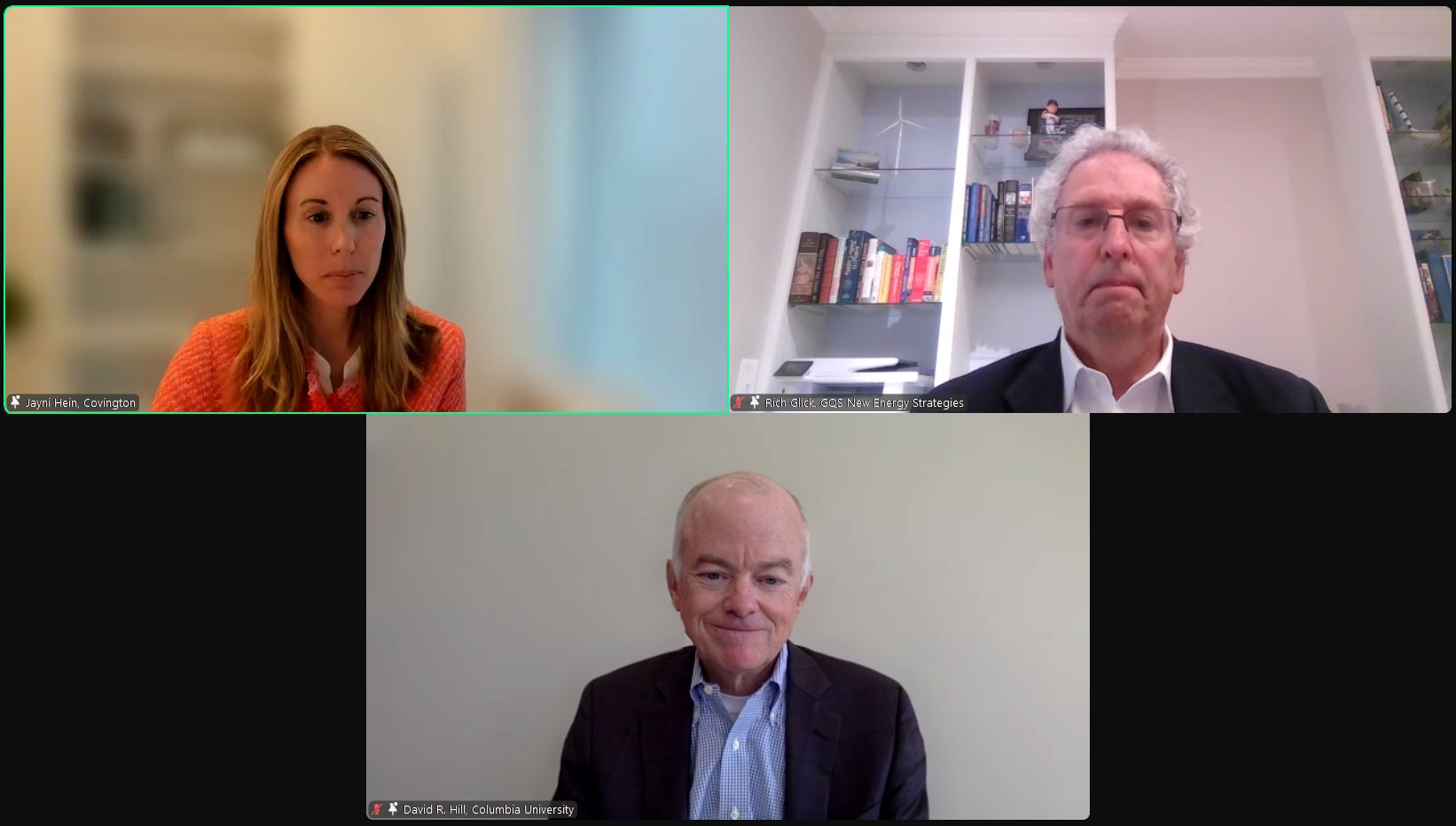Chevron’s Last Dance: Views From Energy Sector Leaders on The Future of Regulatory Power in a New Legal Era

The nation’s courts have long deferred to federal agencies’ interpretations of the statutes they administer, a legal precedent established by the Supreme Court of the United States (SCOTUS) in the landmark 1984 case, Chevron v. Natural Resources Defense Council. On June 28, 2024, SCOTUS overturned the Chevron doctrine by a 6-3 ruling in Loper Bright Enterprises v. Raimondo.
On September 17, the implications of Loper Bright for future rulemakings, especially those impacting clean energy and transmission, were explored in a members-only webinar hosted by the American Council on Renewable Energy (ACORE) featuring two experts: Richard Glick, a Principal at GQS New Energy Strategies, who has served as Chair of the Federal Energy Regulatory Commission (FERC) and as General Counsel for the Senate Energy and Natural Resources Committee; and David Hill, an adjunct Senior Research Scholar at Columbia University’s Center on Global Energy Policy, who previously served as Executive Vice President of NRG Energy and General Counsel at the U.S. Department of Energy (DOE). The webinar was moderated by Jayni Hein, Of Counsel at Covington & Burling LLP, where she co-chairs the firm’s Carbon Management and Climate Mitigation industry group.
ACORE was extremely grateful for the opportunity to hear from these esteemed panelists and in this blog is sharing a summary of some of the key insights.

Perspectives from the History of Chevron
Hein kicked off the webinar by noting that the courts have cited Chevron over 18,000 times in the last 40 years. She explained that many legal scholars have found that Chevron reduced ideological decision-making by judges and helped to achieve greater uniformity and predictability for regulators. But now, instead of deferring to agencies, the Loper Bright decision explains that the courts must “exercise independent judgment in determining the meaning of statutory provisions.”
At the start of the discussion, both speakers reflected broadly on the history of Chevron, finding that the implications are unlikely to be dire. Hill explained that the courts sometimes used Chevron as a crutch to avoid making hard decisions. Loper Bright says that the courts cannot fall back on Chevron to avoid interpreting statutes and owning responsibility for those interpretations. The courts are still going to look to the agency interpretations – and can give them deference and great respect – but cannot give them “binding deference.”
Glick observed that many concerns about Loper Bright have come from environmental and other public interest organizations concerned that Biden administration regulations will be threatened. However, the original Chevron case was decided during the Reagan administration. He had worked for a Democratic senator in the 1990s who tried to overturn Chevron because he saw it as a mechanism to uphold conservative regulations, so the view of Chevron is in the eye of the beholder. In reality, judges have relied on Chevron when they wanted to. When they liked what FERC did, they were likely to have cited Chevron, but when they did not like the order, they would say FERC’s interpretation wasn’t reasonable.
Examining the Implications for FERC
A question frequently asked to Glick about Loper Bright concerns FERC Order 1920 and whether a reviewing court will find that the Commission did not have the authority to require such transmission planning and cost allocation. He explained that in South Carolina Public Service Authority v. FERC, the D.C. Circuit Court of Appeals found that FERC does have such authority and cited Chevron in its decision. In Loper Bright, the Court noted that it is not overturning prior decisions that relied on Chevron, which means that the South Carolina decision is good law. The appeals of Order 1920 are being heard in the Fourth Circuit Court of Appeals, which is not necessarily bound by the South Carolina precedent, but the D.C. Circuit’s reasoning will likely play an important role in the Fourth Circuit proceeding.
How Loper Bright Might Impact Other Agencies
Hill explained that the DOE is not the same type of rulemaking agency as FERC. Most of its rulemakings have been on energy efficiency, the authorizations for which are set forth in great statutory detail. However, rules issued by the Environmental Protection Agency (EPA) often require more interpretation and may be an area where Loper Bright will have more of an impact.
Glick also emphasized the potential impact on EPA rulemakings, observing that SCOTUS is hostile to the Biden administration’s agency rulemakings, as seen in the West Virginia v. EPA decision when the Court “essentially made up” the “major questions doctrine.” But we have not seen that same level of hostility in most of the appellate court circuits.
Additional Cases of Interest
While much attention has been given to Chevron, additional cases warrant attention.
Hill pointed to one such case, which has not yet come before the current SCOTUS, and is relevant to a discussion of attacks on the administrative state. The cornerstone case for independent agencies is Humphrey’s Executor v. U.S., decided during the New Deal. He anticipates that challenges to this case will be coming at some point, which will have significant implications, and recommends keeping an eye on this.
- Humphrey’s Executor involved President Roosevelt’s removal of William Humphrey from the Federal Trade Commission (FTC) based on policy differences. Humprey, who President Hoover had nominated, passed away soon after his dismissal and his executor requested payment of his salary for the time following his removal. The Supreme Court found that the President’s ability to remove a Commissioner from the FTC is limited only to reasons of “inefficiency, neglect of duty, or malfeasance in office.”
- The “major questions doctrine” is a legal theory that SCOTUS relied on when it overturned the EPA’s issuance of the Clean Power Plan under section 111(d) of the Clean Air Act in West Virginia v. EPA. Under the major questions doctrine, an agency must have clear congressional authorization to issue regulations or make decisions of “vast economic and political significance.”
- Another relevant decision, also recently decided by SCOTUS is Corner Post, Inc. v. Board of Governors of The Federal Reserve System. In this case, the Court ruled that that the six-year time frame provided for plaintiffs to bring lawsuits against federal actions does not begin “until the plaintiff is injured by final agency action” rather than when the action occurs. As a result, there is now no clear time limit on legal challenges because newly created entities can claim injury from an action that occurred years earlier.
Hill regards Corner Post as a concerning decision, stating that the idea that you could file a new challenge on a long-standing regulation just by starting up a new business introduces significant regulatory risk and uncertainty. He noted that Congress may need to address this. Glick pointed out that regarding FERC, the Commission’s statutes already strictly limit the time in which a party can file an appeal of a Commission decision to 60 days after the Commission issues an order on rehearing.
Next Steps for Agencies and Congress
In conclusion, the panelists discussed future federal agency and congressional actions following Loper Bright. Glick advised that it is more important than ever before for agencies to make sure that their orders are legally durable. Still, SCOTUS does not “take cert” on everything. Much of the agency decision-making will be litigated at the appellate level, which is generally a less hostile forum for agencies.
Hill referenced the discussion about the West Virginia v. EPA decision, stating that no one knows what the “major questions doctrine” means. Agencies can build an extensive record, and the court can still find something lacking. In light of the recent Supreme Court cases, agencies will likely need to develop even more extensive records.
Both agreed that Congress will need more precise language in statutes going forward.
As we move ahead in a post-Loper Bright and Corner Post world and keep our eyes open for future action on Humphrey’s Executor, ACORE is grateful to these experts for sharing their insights and will continue to keep ACORE members apprised of potential impacts and any developments.
Author

ACORE Team Member
Join leaders from across the clean energy sector.

What will our next 20 years look like? Here’s the truth: they’ll be better with ACORE at the forefront of energy policy.
Shannon Kellogg
Amazon Web Services (AWS)
